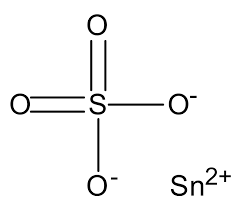HI! I’M ELEMENT AI.
Stannous Sulphate

Product Description
Stannous sulfate, also known as tin(II) sulfate, is a chemical compound with various industrial applications owing to its unique properties.
Product:
Stannous Sulphate
CAS:
7488-55-3
Synonym:
Tin(II) sulfate; Sulfuric acid, tin salt
Structure:

Typical Characteristics
Appearance
White to off-white powder
Density
4.15 g/cm3
Melting point
360 °C (decomp)
Molecular Weight
214.77
Odor
Odorless
Purity
≥95%
Uses, Applications & Markets
Key applications
Markets
get a quote
We Offer Stannous Sulphate
in various grades
A few of the grades available are listed below:



Stannous Sulphate used in many
industry applications
Stannous sulfate, also known as tin(II) sulfate, is a chemical compound with various industrial applications owing to its unique properties. Here are some of its key industrial uses:
- Electroplating: Stannous sulfate is commonly used in the electroplating industry for tin plating of metal surfaces. It serves as an essential component of tin plating baths, where it acts as a source of tin ions for the deposition of thin, protective tin layers onto substrates, such as steel, copper, and aluminum, to enhance corrosion resistance and solderability.
- Chemical Synthesis: Stannous sulfate serves as a versatile reagent and catalyst in various chemical synthesis reactions, particularly in organic chemistry and organometallic chemistry. It is employed in the production of pharmaceuticals, fragrances, dyes, and other fine chemicals, as well as in the synthesis of tin-containing compounds and coordination complexes.
- Metal Surface Treatment: In metalworking and surface treatment applications, stannous sulfate may be utilized as a surface preparation agent or chemical etchant for metal surfaces. It can help remove oxides, scale, and contaminants from metal surfaces prior to plating, coating, or surface finishing processes, improving adhesion and surface cleanliness.
- Catalyst: Stannous sulfate acts as a catalyst in several chemical reactions, including esterification, alkylation, and reduction reactions. It promotes reaction kinetics and facilitates the formation of desired products in organic synthesis, polymerization, and industrial chemical processes, contributing to process efficiency and yield improvement.
- Photography: In the field of photography, stannous sulfate has been used historically as a component of photographic developers and toners. It serves as a reducing agent or developer in black-and-white photography processes, where it helps convert latent silver halide crystals in photographic emulsions into metallic silver, producing visible images on photographic films and papers.
- Textile Dyeing and Printing: Stannous sulfate finds application in the textile industry for dyeing and printing of fabrics and fibers. It may be employed as a mordant or dye fixative in conjunction with certain dyes and pigments to enhance color fastness and dye uptake, resulting in vibrant and durable coloration of textile materials.
- Chemical Analysis: Stannous sulfate is utilized in analytical chemistry techniques, such as titration and spectrophotometry, for the determination of various analytes, including metals, sulfides, and reducing agents. It serves as a reagent or indicator in qualitative and quantitative analysis methods, enabling the detection and measurement of target substances in samples.
- Antimicrobial Agent: In some applications, stannous sulfate may exhibit antimicrobial properties and is used as a biocide or preservative in consumer products, such as antiseptic solutions, disinfectants, and algicides. It helps inhibit the growth of microorganisms, including bacteria, fungi, and algae, in aqueous solutions and formulations.